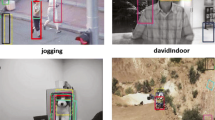Abstract
The powerful theory of compressive sensing enables an efficient way to recover sparse or compressible signals from non-adaptive, sub-Nyquist-rate linear measurements. In particular, it has been shown that random projections can well approximate an isometry, provided that the number of linear measurements is no less than twice of the sparsity level of the signal. Inspired by these, we propose a compressive anneal particle filter to exploit sparsity existing in image-based human motion tracking. Instead of performing full signal recovery, we evaluate the observation likelihood directly in the compressive domain of the observed images. Moreover, we introduce a progressive multilevel wavelet decomposition staged at each anneal layer to accelerate the compressive evaluation in a coarse-to-fine fashion. The experiments with the benchmark dataset HumanEvaII show that the tracking process can be significantly accelerated, and the tracking accuracy is well maintained and comparable to the method using original image observations.
Access this chapter
Tax calculation will be finalised at checkout
Purchases are for personal use only
Preview
Unable to display preview. Download preview PDF.
Similar content being viewed by others
References
Candes, E.J., Tao, T.: Decoding by linear programming. IEEE Transactions on Information Theory 51, 4203–4215 (2005)
Candès, E.J., Romberg, J.K., Tao, T.: Robust uncertainty principles: exact signal reconstruction from highly incomplete frequency information. IEEE Transactions on Information Theory 52, 489–509 (2006)
Candès, E.J., Romberg, J.K., Tao, T.: Stable signal recovery from incomplete and inaccurate measurements. Communications on Pure and Applied Mathematics 59, 1207–1223 (2006)
Candes, E.J., Romberg, J.: Sparsity and incoherence in compressive sampling. Inverse Problems 23, 969–985 (2007)
Duarte, M.F., Davenport, M.A., Takhar, D., Laska, J.N., Sun, T., Kelly, K.F., Baraniuk, R.G.: Single-pixel imaging via compressive sampling. IEEE Signal Processing Magazine 25, 83–91 (2008)
Wright, J., Yang, A.Y., Ganesh, A., Sastry, S.S., Ma, Y.: Robust face recognition via sparse representation. IEEE Transactions on Pattern Analysis and Machine Intelligence 31, 210–227 (2009)
Cevher, V., Sankaranarayanan, A., Duarte, M., Reddy, D., Baraniuk, R., Chellappa, R.: Compressive sensing for background subtraction. In: Forsyth, D., Torr, P., Zisserman, A. (eds.) ECCV 2008, Part II. LNCS, vol. 5303, pp. 155–168. Springer, Heidelberg (2008)
Mei, X., Ling, H.: Robust visual tracking using l1 minimization. In: ICCV 2009, pp. 1436–1443 (2009)
Magnenat-Thalmann, N., Laperrière, R., Thalmann, D.: Joint-dependent local deformations for hand animation and object grasping. In: Proceedings on Graphics Interface 1988, Canadian Information Processing Society, pp. 26–33 (1988)
Natarajan, B.K.: Sparse approximate solutions to linear systems. SIAM Journal on Computing 24, 227–234 (1995)
Deutscher, J., Blake, A., Reid, I.: Articulated body motion capture by annealed particle filtering. In: Proceedings of IEEE Conference on Computer Vision and Pattern Recognition, vol. 2, pp. 126–133 (2000)
Kirkpatrick, S., Gelatt, C.D., Vecchi, M.P.: Optimization by simulated annealing. Science 220 (4598), 671–680 (1983)
Baron, D., Duarte, M.F., Wakin, M.B., Sarvotham, S., Baraniuk, R.G.: Distributed compressive sensing. The Computing Research Repository abs/0901.3403 (2009)
Baraniuk, R.G., Wakin, M.B.: Random projections of smooth manifolds. Foundations of Computational Mathematics 9, 51–77 (2009)
Johnson, W., Lindenstrauss, J.: Extensions of Lipschitz mappings into a Hilbert space. In: Conference in modern analysis and probability (New Haven, Conn., 1982). Contemporary Mathematics, vol. 26, pp. 189–206. American Mathematical Society, Providence (1984)
Householder, A.S.: Unitary triangularization of a nonsymmetric matrix. Journal of the ACM 5, 339–342 (1958)
Sigal, L., Black, M.J.: Humaneva: Synchronized video and motion capture dataset for evaluation of articulated human motion. Technical report, Brown University, Department of Computer Science (2006)
Daubechies, I.: Ten Lectures on Wavelets. CBMS-NSF Regional Conference Series in Applied Mathematics. SIAM, Philadelphia (1992)
Author information
Authors and Affiliations
Editor information
Editors and Affiliations
Rights and permissions
Copyright information
© 2011 Springer-Verlag Berlin Heidelberg
About this paper
Cite this paper
Lu, Y., Wang, L., Hartley, R., Li, H., Xu, D. (2011). Compressive Evaluation in Human Motion Tracking. In: Kimmel, R., Klette, R., Sugimoto, A. (eds) Computer Vision – ACCV 2010. ACCV 2010. Lecture Notes in Computer Science, vol 6495. Springer, Berlin, Heidelberg. https://doi.org/10.1007/978-3-642-19282-1_15
Download citation
DOI: https://doi.org/10.1007/978-3-642-19282-1_15
Publisher Name: Springer, Berlin, Heidelberg
Print ISBN: 978-3-642-19281-4
Online ISBN: 978-3-642-19282-1
eBook Packages: Computer ScienceComputer Science (R0)




